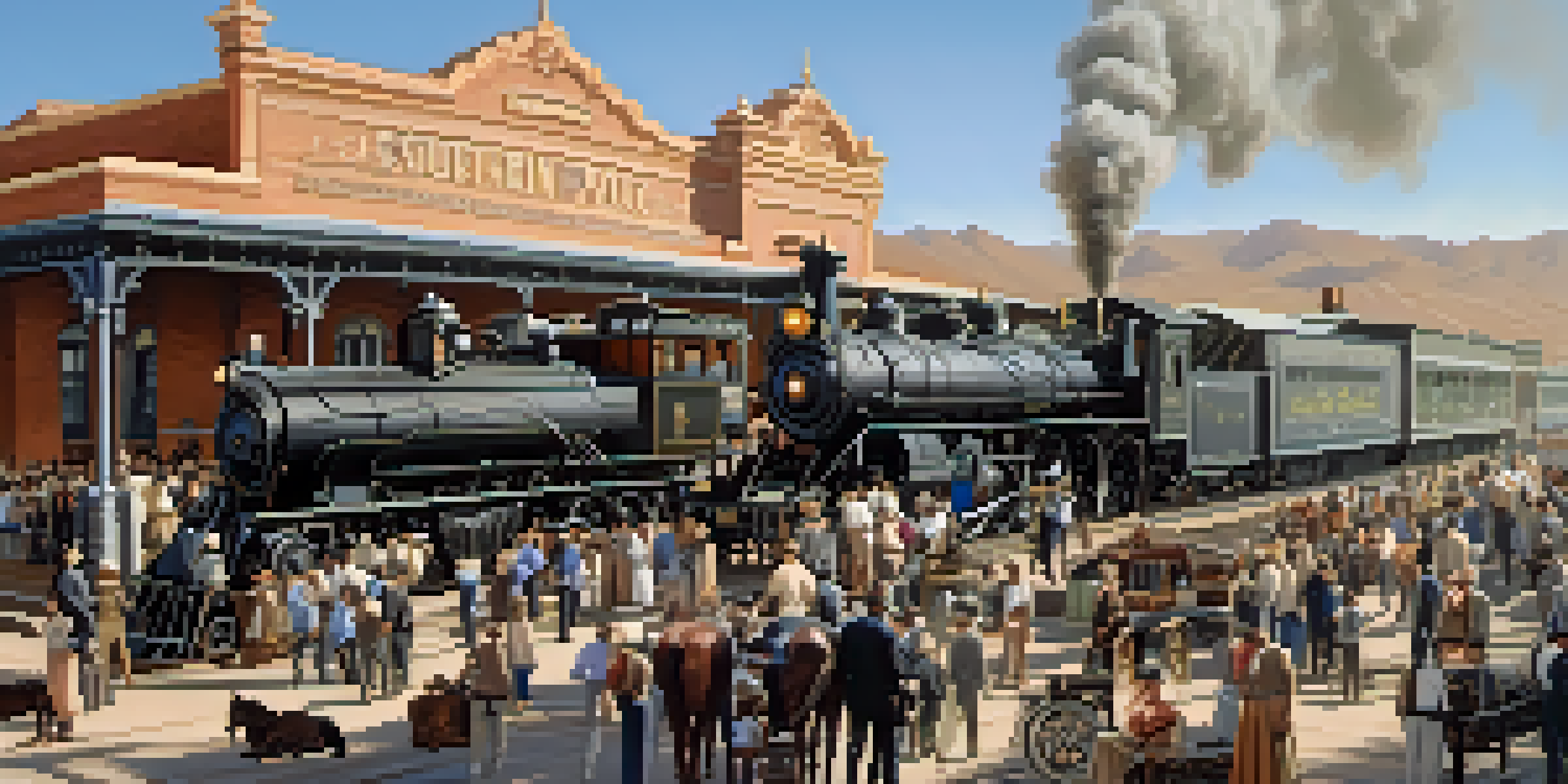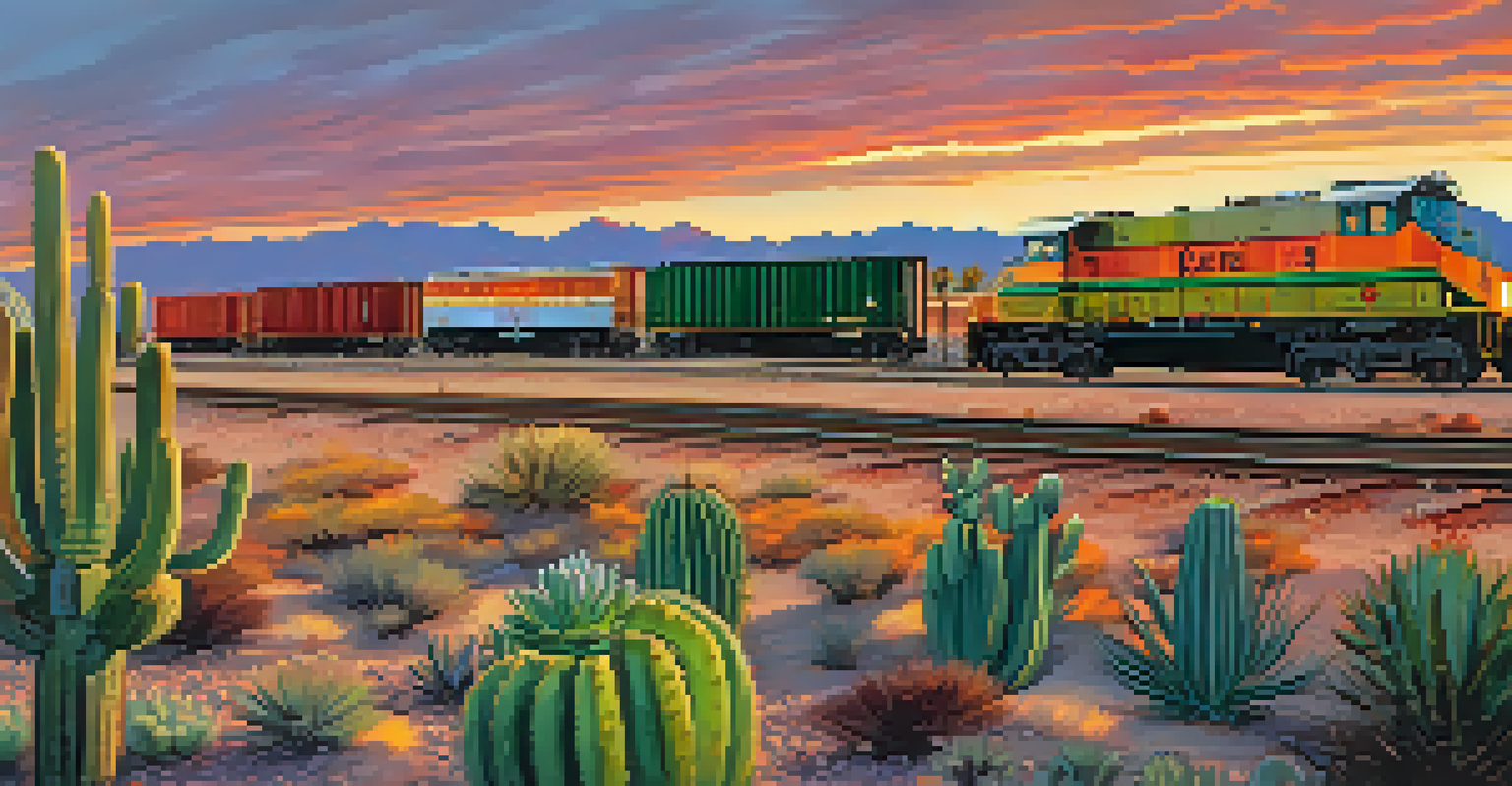The Impact of Railroads on Tucson's Economic Growth

The Birth of Railroads in Tucson: A Historical Overview
The arrival of railroads in Tucson in the late 19th century marked a turning point for the city's economy. Initially, the Southern Pacific Railroad connected Tucson to major markets, allowing goods to flow in and out more efficiently. This newfound connectivity spurred growth in local industries and attracted new businesses, eager to capitalize on the increased trade opportunities.
The railways are the arteries of the country; they are the lifelines that connect communities and foster economic growth.
As railroads expanded, they not only facilitated trade but also transformed Tucson into a key transportation hub in the Southwest. This strategic location made it easier for farmers and merchants to reach larger markets, ultimately enhancing the region's agricultural output. The city became a vital link between the U.S. and Mexico, showcasing the power of railroads in shaping economic landscapes.
By the early 20th century, the impact was undeniable: Tucson's population boomed, and new businesses flourished. The railroads not only brought economic growth but also cultural exchanges, as people from diverse backgrounds arrived seeking new opportunities. This rich tapestry of influences continues to shape Tucson's identity today.
Economic Diversification: Railroads as Catalysts
Railroads played a crucial role in diversifying Tucson's economy, which had previously relied heavily on agriculture. With improved transportation, industries such as mining, manufacturing, and retail emerged, creating a more balanced economic landscape. This diversification helped the city withstand economic downturns, as it was no longer solely dependent on one sector.

For instance, the mining industry benefited immensely from railroad access, as minerals could be transported quickly to processing plants and markets. This not only generated jobs but also attracted investments in infrastructure and technology. The ripple effect of these developments contributed to a more robust economy overall.
Railroads Boosted Tucson's Economy
The arrival of railroads in Tucson catalyzed economic growth by enhancing trade, attracting businesses, and diversifying industries.
Moreover, as Tucson's economy grew, so did its appeal to new residents and businesses. The influx of people brought new talents and ideas, further stimulating innovation and economic activity. The synergy between railroads and economic diversification laid the groundwork for Tucson's vibrant, multifaceted economy.
Job Creation: The Direct Impact of Railroads
One of the most significant impacts of railroads on Tucson's economy was job creation. The construction and operation of rail lines required a substantial workforce, providing employment opportunities for many residents. This influx of jobs not only helped families thrive but also stimulated local businesses as workers spent their earnings in the community.
Transportation is a vital element in the economic development of a community, linking it to markets and opportunities.
Beyond direct employment, railroads also contributed to job creation in various supporting industries, such as shipping, logistics, and hospitality. These ancillary jobs further enhanced Tucson's economic vitality, turning it into a bustling urban center. The interconnectedness of these sectors illustrates how railroads served as a backbone for economic growth.
As Tucson continued to grow, the demand for skilled workers pushed educational institutions to adapt and expand their programs. This focus on workforce development ensured that residents could access the necessary training for emerging industries, solidifying the positive impact of railroads on job creation and local prosperity.
Infrastructure Development: Railroads and Urban Growth
The growth of railroads in Tucson catalyzed significant infrastructure development throughout the city. As rail lines expanded, so did the need for supporting structures like depots, warehouses, and bridges. This surge in construction not only improved transportation efficiency but also enhanced the overall urban landscape.
With better infrastructure in place, Tucson could support a growing population and increasing economic activity. Roads, utilities, and public services were upgraded to meet the demands of a bustling city, creating a foundation for long-term growth. The interconnectedness between railroads and urban development highlights the symbiotic relationship that fueled Tucson's progress.
Job Creation Through Rail Expansion
The construction and operation of railroads generated significant job opportunities, positively impacting local communities and supporting ancillary industries.
Moreover, this infrastructure development set the stage for future advancements, such as the establishment of public transportation systems. These systems further connected neighborhoods and facilitated movement, contributing to a more integrated and accessible city. The impact of railroads on Tucson's infrastructure continues to be felt today, shaping the city’s urban planning.
Cultural Exchange: Railroads and Community Interaction
Railroads not only transformed Tucson's economy but also facilitated cultural exchanges among diverse communities. As people from various backgrounds traveled through the city, they brought with them unique traditions, customs, and ideas. This cultural melting pot enriched Tucson's social fabric, making it a vibrant place to live and work.
Events, festivals, and markets emerged as venues for showcasing the diverse influences that railroads helped bring together. Local businesses thrived on this cultural richness, offering products and services that reflected the community's varied heritage. The intersection of cultures continues to define Tucson's character, enhancing its appeal as a destination for residents and tourists alike.
Additionally, the railroads fostered a sense of connectivity and unity among residents. As people traveled and interacted with one another, they built relationships that transcended cultural boundaries. This strengthened the community and laid the groundwork for a collaborative spirit that persists in Tucson today.
Challenges Faced: The Flip Side of Railroads
While the impact of railroads on Tucson's economic growth is largely positive, it also came with challenges. The rapid expansion of rail infrastructure sometimes led to environmental degradation, as natural habitats were disrupted. Balancing economic development with environmental sustainability became an ongoing concern for the community.
Moreover, as businesses flourished along the rail lines, some neighborhoods experienced displacement and gentrification. The influx of new residents and businesses sometimes pushed long-established communities out, altering the demographic landscape of Tucson. This highlights the complexities associated with economic growth driven by railroads.
Cultural Exchange Enriched Communities
Railroads facilitated cultural interactions among diverse populations, contributing to Tucson's vibrant social fabric and community spirit.
Today, Tucson continues to grapple with these challenges as it seeks to promote sustainable development. Efforts to preserve natural spaces and support diverse communities reflect the city's commitment to ensuring that the benefits of economic growth are shared equitably among residents.
The Future of Railroads in Tucson: Opportunities Ahead
Looking ahead, railroads remain a vital component of Tucson's economic strategy. With the rise of freight transportation and passenger rail initiatives, there are exciting opportunities to further enhance connectivity. Investments in modernizing rail infrastructure can bolster economic growth while providing sustainable transportation options.
Moreover, as e-commerce continues to shape the retail landscape, railroads play a crucial role in facilitating the movement of goods across the region. This adaptability keeps Tucson competitive in an ever-evolving market, ensuring that the city remains a key player in the Southwest's economy. The potential for innovation and growth is promising.

In addition, community-led efforts to expand public transportation options, including rail services, highlight the importance of accessibility for all residents. By prioritizing sustainable and inclusive transportation solutions, Tucson can build on its railroad legacy to create a thriving, interconnected future that benefits everyone.